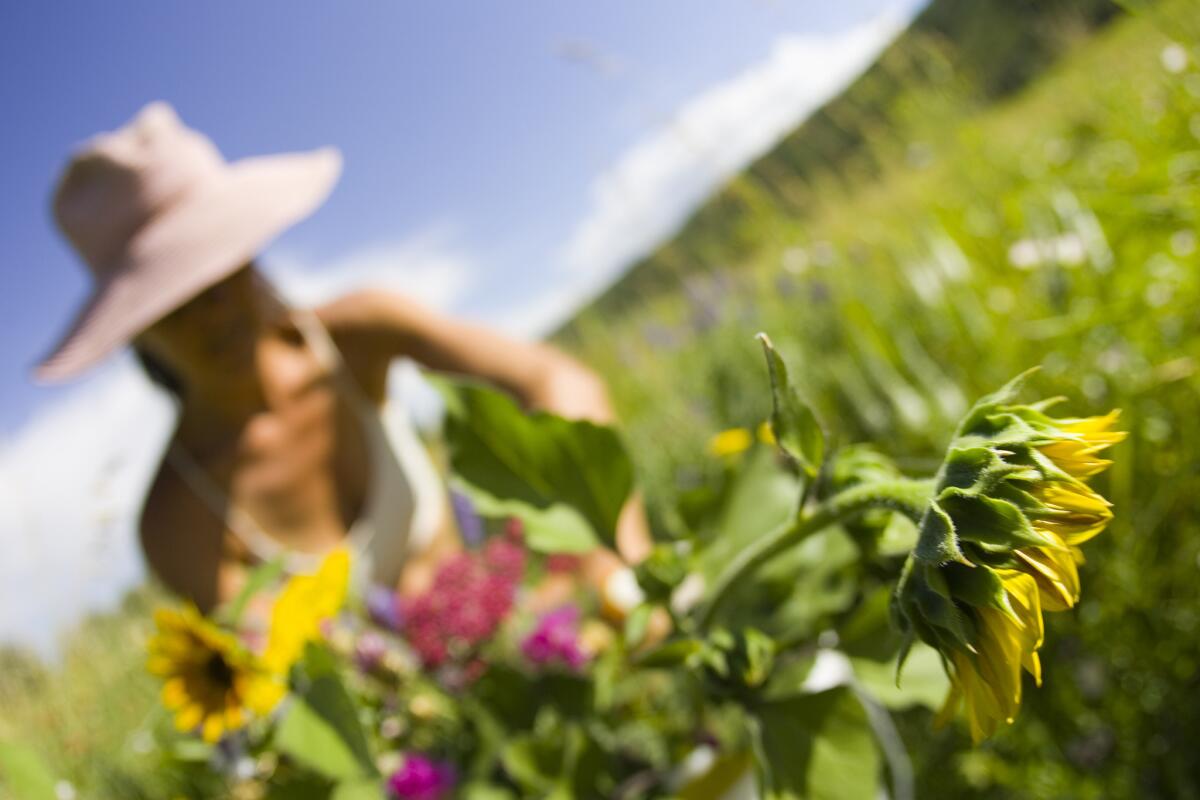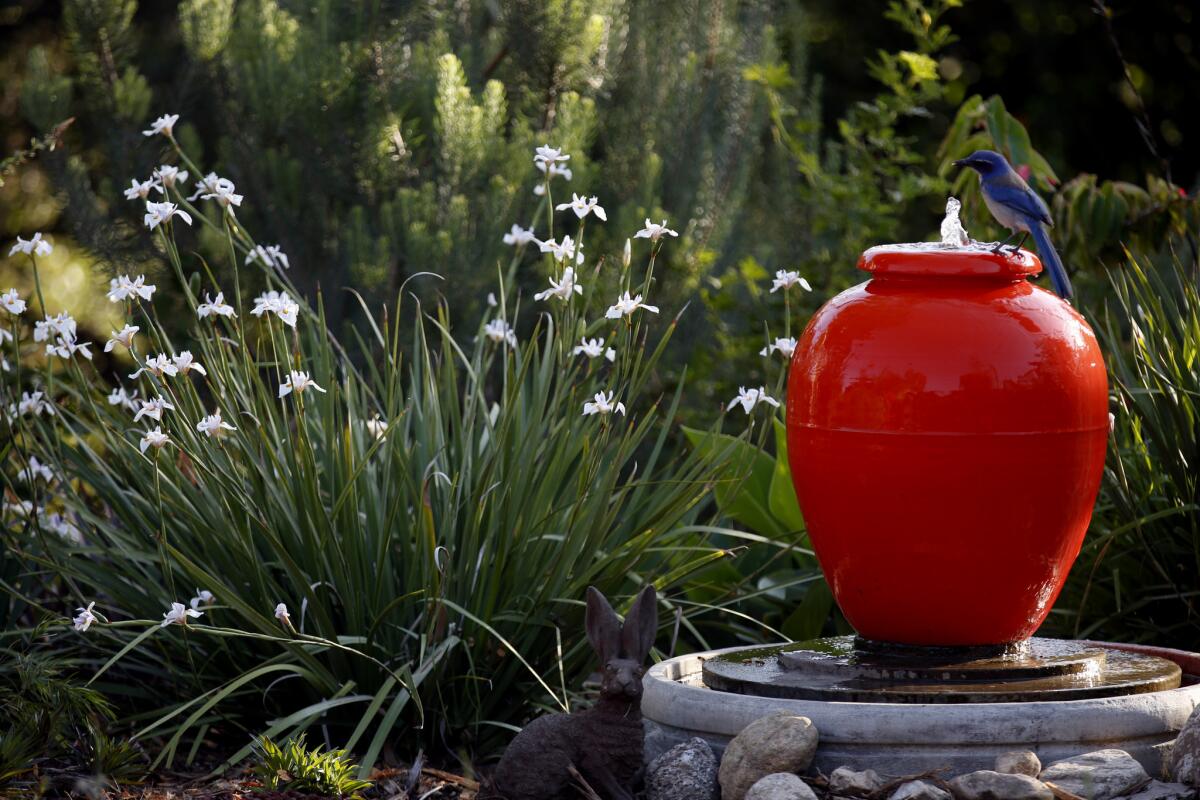When watering a plant is the biggest mistake you can make

- Share via
Summer’s heat hit early and hit hard. Plants are crunchy and dry, especially in the inland valleys. Pests seem as desperate for our produce as we are. In the hot days of summer, it is important to care for yourself while you care for your garden. Here are 26 ways to do just that:
1. Garden early in the morning and in the later afternoon to avoid the midday heat and sun. Wear sunscreen, a hat and long sleeves to protect your skin. Drink plenty of nonalcoholic beverages (enjoy the alcohol after the sun goes down).
2. Poor air circulation and wet leaves create ideal conditions for powdery mildew and other fungi that affect melons, cucumbers and squash. Ensure good air circulation by growing vining plants on sturdy trellises. Keep leaves dry by watering the soil, not the leaves, using drip irrigation or soaker hoses.
3. Some gardeners are under the mistaken impression that removing leaves or cutting back branches encourages plants to make more fruit. The exact opposite is true. Flowers and fruit require huge amounts of energy. Energy comes from photosynthesis that happens in leaves. If you remove leaves, you remove the engine that powers plants to flower and fruit.
4. Soft brown spots on the bottom ends of tomatoes or squash are sure signs of blossom end rot, which happens when soil alternates between very wet and very dry. Solve the problem by adjusting irrigation so that soil is constantly damp instead. Mulch with a 2- or 3-inch-thick layer of straw (not hay).
5. Pick fruit as it ripens. Compost those that are damaged, overripe or drop on their own. Otherwise, they’ll draw rats or other hungry critters into the garden.
6. Add a fountain or birdbath near your vegetable garden so birds and other pollinators have a reliable water source.

7. The lower leaves on tomato plants, especially heirloom tomatoes, are starting to turn brown and die now. These old varieties have little resistance to bacteria, viruses and other plant pathogens that live in the soil. Next year, look for varieties labeled with “V” (verticillium wilt resistant), “F” (Fusarium wilt resistant), and “N” (nematode resistant). These varieties are bred to be resistant to these common maladies.
8. It is common to lose drought-tolerant shrubs now. First, leaves start to brown, then the whole plant is gone. Avoid your first impulse to water. The plants are succumbing to fungi that thrive in wet, warm soil. So stop watering and let the soil dry out. You may not save a plant that is struggling now, but you’ll preserve the rest.
9. Water drought-tolerant shrubs in the Protea family (Grevillea, pincushions, Proteas, conebushes and others) at night while the air and soil are cool. Water once a week, with just 2 or 3 gallons per plant each time you water.
10. Deep-soak drought-tolerant natives once every three or four weeks, no more. For plants experiencing their first summer in the ground, water lightly in between deep waterings, but let the soil drain first. Waterlogged soil can kill these plants.
11. Too-dry shrubs (including roses) and too-dusty leaves are vulnerable to tiny spider mites that make dense webs on leaves, fruit, twigs and branches. Spider mites have natural enemies, so don’t spray with a poison. Instead, spray the leaves with water to keep them clean, both tops and undersides. Keep plants adequately irrigated.
12. Although there are no water restrictions now, water is still limited. Limit your thirsty ornamental plants and put them where they are most visible. Plant the rest of the garden areas with drought-tolerant plants
13. Plumeria are peaking now. Look for your favorites, then shop around. One of our favorite sources: The Southern California Plumeria Society sale in San Diego, which takes place over Labor Day weekend.
14. Do you still have lawn? Kill it with the sun. Solarize by first mowing the grass very, very short. Irrigate to saturate the soil a foot deep, then cover with 1- or 2-ml-thick sheets of clear plastic. Overlap seams if you need multiple sheets. Weigh down the edges. Turn the water off, then wait six to eight weeks as the soil superheats to kill the grass and weeds. After the lawn turns straw colored, it’s dead.
15. Buy spring bulbs now. Those bulbs that are dormant will bloom in spring: baboon flower (Babiana), bugle flower (Watsonia), gladiola, harlequin flower (Sparaxis) and others, mostly from South Africa.
16. Buy seeds for fall and winter cover crops. Cover crops add nitrogen and organic matter to vegetable garden beds. Sow seeds in September, but buy them now, while they are in stock.
17. Start seeds for fall veggies like kohlrabi, cauliflower, spinach and arugula. Seedlings started will be ready to plant in the garden around the end of September, just in time for October’s cooler weather.
18. Gardeners in the inland valleys and near (but not at) the coast can plant one more round of summer vegetables. Plant seedlings of basil, eggplants, tomatoes, cucumbers, squash, even pumpkins.
19. Citrus, avocado, mango, banana and other tropical fruiting plants are not drought-tolerant, so irrigate regularly and deeply (but don’t let soil become waterlogged). Feed with organic fertilizer specifically for tropical fruiting plants. Follow label directions.
20. Avocado trees need a thick layer of mulch over their roots, so allow leaves to accumulate rather than raking them away. Cover the soil beneath young trees with mulch. Don’t dig or cultivate under the trees to avoid hurting tree roots.
21. Harvest figs as they ripen. Unlike most fruit, a fig picked unripe will never ripen.
22. Summer prune (rather than winter prune) fruit trees to keep them small and the fruit within easy reach.
23. Keep worm bins in shade. In sun, those black bins heat up and cook the worms.
24. Put houseplants in a shady spot outside for fresh air and rejuvenation. Leave them outside until October.
25. Remove spent blooms on roses to encourage fall flowers. Deeply irrigate periodically
26. Plant carrots, beets, radishes and leeks from seed now.
Sterman is a water-wise garden designer and writer. Her website is plantsoup.com
Dry does not mean dull
What: Gardening expert Nan Sterman, signs copies of her book “Hot Color, Dry Garden” and shows you how to have a colorful garden that’s also drought tolerant
When: 11 a.m. Aug. 4
Where: Potted, 3158 Los Feliz Blvd., Los Angeles
Cost: The talk is free. Book is $24.95
Info: pottedstore.com, (323) 665-3801






